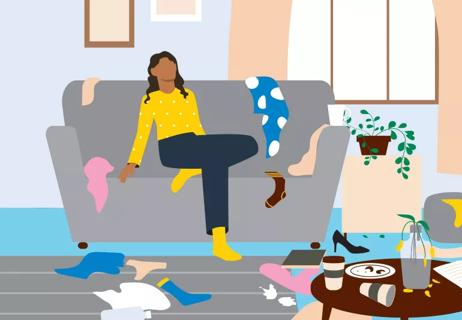Both meds have similar benefits and side effects

Finding the right medication that works for you is often a trial-and-error process, especially when it comes to treating your mental health. Our minds and bodies are unique, so the goal with medication is to provide substantial, positive results with few (if any) side effects that are tolerable and manageable.
Advertisement
Cleveland Clinic is a non-profit academic medical center. Advertising on our site helps support our mission. We do not endorse non-Cleveland Clinic products or services. Policy
Attention-deficit/hyperactivity disorder (ADHD) is characterized by behavioral challenges and executive dysfunction that disrupt a person’s ability to manage their emotions, focus and pay attention to completing important tasks, follow directions and regulate overactivity. As one of the most studied neurodevelopmental disorders in children, it can also manifest later in life or carry over into adulthood. But whenever it’s diagnosed, at age 6 or later, a healthcare provider may prescribe different medications to help treat the symptoms associated with ADHD.
Stimulant medications are most often looked to as a first-line treatment for ADHD because they help streamline information to your brain and help you focus on what’s most important, with an increase in awareness and clarity. Most stimulants fall into two categories: methylphenidate or amphetamine. But deciding on which stimulant to try is often a toss-up, leaving many people wondering which is better or worse: Concerta® (methylphenidate) or Vyvanse® (lisdexamfetamine)?
Though there are other stimulant medications available (along with generic options and nonstimulant medications for ADHD), Concerta and Vyvanse are usually the frontrunners for people interested in medication because of the extensive research and clinical trials that have been done on them in the past.
Advertisement
Pediatrician Kimberly Giuliano, MD, shares the similarities and differences between these two medications, and how they work.
Both Concerta and Vyvanse are stimulant medications that increase dopamine and norepinephrine in your brain. These chemicals play an important role in how you concentrate, think and stay motivated when focusing on your responsibilities and completing day-to-day tasks.
“Stimulant medicines have the most significant impact on symptom management when compared to nonstimulant medicines,” explains Dr. Giuliano. “Nonstimulants might have some mild benefits, but they’re not nearly as robust as what we see from stimulant medicines.”
Because of their similarities and design, both Concerta and Vyvanse have the same benefits, including:
“The main difference is that some people’s genetic and biological makeup will result in a better improvement with one medicine instead of the other,” clarifies Dr. Giuliano. “But they both work in similar ways and have the same potential benefits, as well as the same potential side effects.”
Both Concerta and Vyvanse are extended-release medications, meaning you only have to take one once a day (usually in the morning) because they’re formulated in such a way that the medication is released into your body slowly over time.
“It gives a person the ability to manage their ADHD symptoms throughout the bulk of their day, and usually the uptake as well as the letdown of the medicine is relatively smooth,” says Dr. Giuliano.
Studies have shown that extended-release medications like Concerta and Vyvanse are actually widely preferred because of their once-daily dosing. Typically, these medications start working within 30 minutes to an hour and they can last for up to seven to 12 hours at a time.
“Some people will notice a quick kick-in and others might notice a more gradual onset of benefits,” she says. “If the medicine is at a higher dose, people might feel a little bit more of a jolt than someone who’s on a more moderate-to-low dose.”
If someone needs additional ongoing benefits beyond what the typical extended-release medications allow — say for after-school activities or longer work days — a healthcare provider might also prescribe an additional short-acting (or immediate-release) medication. In younger children who have a hard time tolerating extended-release medications, especially, short-acting medications may be an alternative.
Advertisement
“In those instances, we’ll use a short-acting medicine for a year or two until they get a little older and can successfully transition over to an extended-release medicine,” explains Dr. Giuliano. “But using just short-acting medicines isn’t common because they only last for a few hours and they have to be dosed two to three times a day.”
For the most part, studies have shown that Concerta and Vyvanse can cause similar side effects that include:
People who take Vyvanse may also experience fatigue, and both medications can cause sleep disturbances like insomnia if they’re taken too late in the day.
“Many of the most common side effects like headaches and abdominal pain will eventually go away on their own or become much more mild and tolerable over time,” says Dr. Giuliano.
But the most serious side effects you should watch out for include:
“Sometimes, these medicines can make kids feel more irritable, sad or withdrawn,” notes Dr. Giuliano. “Anytime we’re altering the chemicals in the brain, these side effects are a potential risk. So, for anything that’s making the child more sad, moody or irritable, we want to intervene, so we don’t really reach the point where a child is having significant depression or thoughts of suicide.”
Advertisement
These medications can also cause an increase in heart rate and blood pressure, so you’ll want to notify your healthcare provider if you have a family history of early heart disease or unexplained death.
“If there are any concerns about your child’s heart, you should have them evaluated by a cardiologist before starting the medication,” warns Dr. Giuliano.
It’s hard to say whether Concerta or Vyvanse is better because it depends on how your body reacts, the dosage your healthcare provider prescribes and the severity of side effects you experience (if any). Both Concerta and Vyvanse are available in pill form, but Vyvanse is also available in chewable tablets — and different forms of medications may also be associated with different outcomes.
“Sometimes, it’s a bit of a trial-and-error process to figure out which class of stimulant medications is best for you, so it’s important to work with a healthcare provider who can help you through the process and answer any questions you have along the way,” advises Dr. Giuliano. “When the side effects start to outweigh the improvement that’s been noticed, that’s where we might start to look at switching to a different medication.”
“Most of the time, kids who start these medicines actually have an improved mood because they’re more successful in school, it’s easier to get their work done and they get less frustrated,” says Dr. Giuliano. “Often, they feel better about themselves when they experience an increased ability to pay attention and focus.”
Advertisement
People who have challenges with hyperactivity or impulsivity might also find it easier or more common for them to remain calm or pause and act before they think as opposed to having impulse-driven behavior when they’re not taking the medication.
“You know these medications are working if you realize you’re more on-task, you get your work done in a more efficient manner, and it’s done to a higher quality than when you’re not taking the medicine,” she says.
And for people who have a hard time discerning whether or not these medications are effective (especially younger children), a healthcare provider might have parents, teachers and other people in your life complete rating scales about how you were doing before you started the medicine and how you’re doing after you’ve started the medicine, or whenever there’s a change in your medication or dose adjustment.
“We’ll look back on those scales to get some more objective assessments and look at specific behaviors that somebody might be struggling with to see if we’re moving the needle in terms of helping them to manage their symptoms,” she continues.
Of course, treatment doesn’t always happen in a medically sealed vacuum. Healthcare providers often prescribe cognitive behavioral therapy alongside medication to treat symptoms of ADHD so you can learn positive coping and management skills to deal with symptoms in the moment that they occur.
For young children, this might mean learning social skills, as well as behavior modifications for more obtrusive behavior like yelling, getting out of their seat in class and causing other disruptions.
“We want to find ways to harness their energy in more productive fashions so that they’re not getting themselves into trouble,” says Dr. Giuliano.
For older kids and adults, behavioral therapy might be more focused on organizational skills, time management and executive functioning skills.
“When your medicine wears off at the end of the day or it hasn’t kicked in yet in the morning, having some great habits to fall back on can help compensate when the medicines aren’t in your system to help you out,” says Dr. Giuliano.
Whatever your experience with ADHD — and no matter how you choose to treat it, with Concerta, Vyvanse or other medications — a healthcare provider can help answer or alleviate any questions or concerns you have while also pointing you in the right direction so you can feel back on track with your mental health.
Learn more about our editorial process.
Advertisement

Background stimulation and intentional fidgeting may actually help you stay on task

A booster dose, healthy snack and some downtime may help ward off a medication rebound

Working side by side with another person can improve focus, build accountability and provide motivation to get a task done (or at least started)

The medical condition isn’t a learning disability and doesn’t always cause hyperactivity

There are times and cases when physician-supervised breaks may be beneficial

Using time management tools, adopting new approaches and allowing for a little grace can help meet deadlines and finish tasks

Boys might seem disruptive, while girls might seem inattentive, but ADHD isn’t a sex-specific condition

Start by doing just one small thing first, and then, check it off your list

Babies can get congested easily, but you can calm their cough by keeping them hydrated, using nasal drops and running a humidifier

Weight loss may cause loose, sagging skin and muscle loss to your rear

Several conditions, like vitiligo and fungal infection, can cause a loss of pigmentation, leading to white spots or patches on your skin